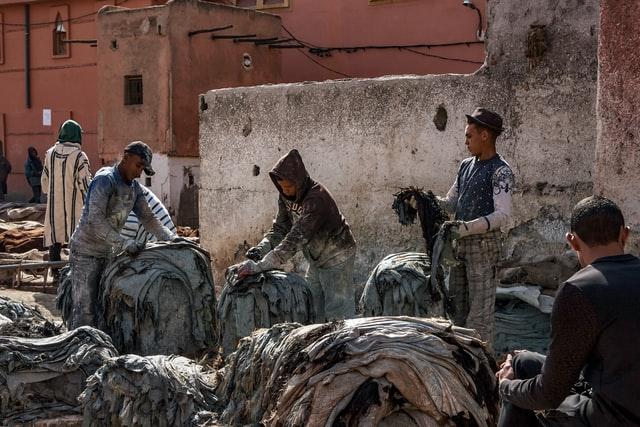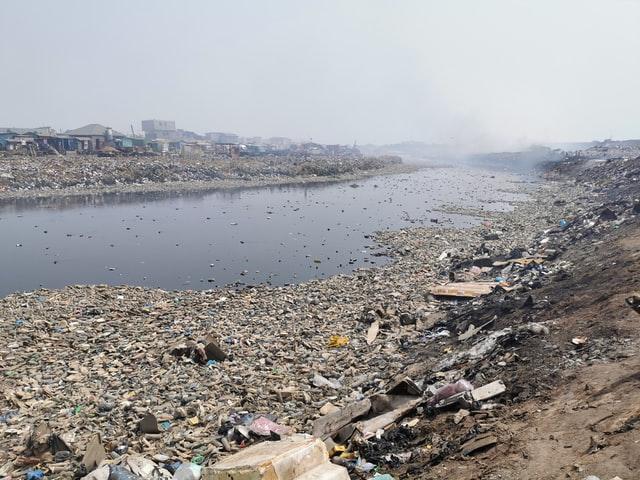When it comes to fashion you think about branded handbags, dresses, scarves, belts or shoes but what about garbage and other abuses! Over the past decades, our shopping habits have transformed and our wardrobes expanded.
Buying clothes has never been easier and cheaper. We’re constantly bombarded with media that puts pressure on us to buy newer and trendier clothes. Just to throw them away when they’re no longer in style.
The so-called ‘fast fashion’ allows consumers to buy more than what is really needed. These garments are worn a couple of times and are disposed at an unprecedented rate.
Yet while our bursting wardrobe may make us feel complete for a while, it’s the environment that is bearing the devastating cost. The environment is facing an irreversible climate crisis as human consumption has led to an unprecedented amount of garbage.
Between 80 billion and 150 billion garments are manufactured and sold every year. And most of that product ends up in landfills. An estimated 93 million tons go to landfills or are burned every year.
In the UK alone, more than 300,000 tonnes of clothes end up in landfills every year. It’s the fastest-growing category of waste in the country. But this is a global problem. Expanding middle classes in emerging markets are hungry for more and cheaper fashion. It’s estimated that by 2050, global clothing sales could more than triple.

Contents
What is fast fashion?
Clothes shopping used to be an occasional event. Which happened a few times a year when the seasons changed or when we outgrew what we had. During the past decade, clothes became cheaper and shopping became a hobby. What once was considered an occasional event has now become a monthly if not weekly event for some.
Hence all this has created the fast fashion system which now dominates the shopping industry. The term fast fashion is used to describe clothing designs that move quickly from the fashion runway to shops to take advantage of trends.
This type of clothing loop allows consumers to purchase hot new design clothing at an affordable price. The design, manufacturing and marketing method focused on rapid production in high volume.
The industry produces trend replicas with low-quality materials to bring inexpensive styles to the public. Suddenly everyone could afford the dress their favorite celebrity wore or the latest trends from the fashion runway.
These cheaply made pieces have resulted in overconsumption. Hence, people buy these cool and trendy clothing cheaply and wear them a handful of times before throwing them away. Unfortunately, all these cheap clothes have resulting impacts on the environment and also garment workers and human life.
The problem with fast fashion
Fast fashion’s impacts on the planet are tremendous. In the US alone, the garment industry is estimated to go from 1.9 trillion in 2019 to reach $3 trillion by 2030. Such numbers show how big and lucrative the market is and there is a problem of consumerism with no sight of stopping.
While the impact of fast fashion and consumerism can be seen in our lives, on social media and wardrobes, it’s somehow difficult to assess how damaging the clothing industry is to the environment. Hence making it even harder for the industry to become sustainable.
According to BWSS, fast fashion is a business model that focuses on cheap materials and labor to mass-produce clothing collections. This pressure for cheap and mass production of clothing is because fashion trends are only temporary become outdated very fast.
There is also the growing desire of the consumer for fast and cheap clothing. Hence, the pressure to reduce costs and speed up production means that human and environmental impacts are more likely to be cut.
It’s quite hard to decide what comes first, the impulse for always looking fresh or fashioned or big fashion brands convincing people they are behind or trends become outdated as soon as they come out.
However, a lot of factors have contributed to the popularity of the fast fashion trend. Factors such as:
- Cheaper manufacturing
- Speedier shipping
- Massive marketing campaign
- Increased consumer appetite for fashion
- Social media
- Consumer purchasing power especially among youth
- Search for instant gratification
There is no doubt that we thirst for trending and up-to-date products. However, this consumer-driven life has a devastating impact. The clothing industry produces vast amounts of waste.
The global production of textile goods from the period of 1975 to 2018 is estimated to have doubled from 5.9kg to 13kg. And most of these textile products are worn just a handful of times before being thrown away.
Less than 1% of thrown garments are recycled and the majority of the textile waste products are burnt or go to landfills. A study from Labfresh found that 57% of textile waste from 15 countries across Europe ends up in landfills.
The textile waste consists of used items as well as garments that never even reached the consumer due to trends becoming outdated and or consider not good enough to be sold. According to Vox, the fashion industry is connected to climate change.
The industry is heavily dependent on synthetic fibers such as polyester, nylon, acrylic and elastane. These materials are made from petrochemicals (fossil fuels) and are now found in over half of all textiles produced.
The fiber in clothing is made from plastic and will never fully decompose and is rarely recycled. With time these fibers break into microplastics, thus harming wildlife and emitting carbon dioxide into the atmosphere.
Another material commonly used is cotton which accounts for 6% of the world’s pesticides and 16% of insecticides. These materials are cheap and therefore allow clothing companies to keep prices low at a high environmental price tag.
This microplastic use in clothing means that the textile sector accounts for 15% of total plastic use. According to the Ellen MacArthur Foundation, clothes are a major contributor of microfibres into the ocean every year.
Every time you wash your clothes around 700,000 microfibres could be shed which are consumed by aquatic organisms. The industry also consumes a lot of water for textile treatment and dyeing resulting in around 20% of industrial water pollution with goes untreated.
This untreated toxic water contains substances like lead, mercury and arsenic that are very harmful to human, animal and aquatic life. It takes 200 tons of water to dye and finish one ton of fabric. The processing of leather consumes 300kg of chemicals for every 900kg of animal hides tanned.

In Bangladesh, 22,000 cubic liters of toxic wastewater from tanneries goes to waterways and rivers every year. Where everything along the river banks is affected. Apart from all this, the industry is also responsible for around 8-10% of global carbon emissions.
According to ‘Unearthed’ Greenpeace, if fast fashion continues to grow at its current rate this number can reach 26% by 2050. China, Bangladesh and India are the big players in the production of clothing and these countries are powered almost entirely by coal.
The fast fashion industry also hurts soil, woodland and entire ecosystems. Sheep are raised for their wool which causes overgrazing. Overgrazing leads to soil erosion, land degradation, and loss of plant species which can lead to food shortages and famine.
The effects of fast fashion
The fast fashion industry relies on heavy consumption-based models, with the planet and workers paying the price. The use of cheap and toxic materials makes the industry the second largest polluter of clean water globally.
Polyester is one of the most popular fabrics used in garments and it is obtained from fossil fuels. Hence this material contributes to global warming and sheds microfibers in water when washed. These microfibers contribute to the levels of plastic in our oceans.
Another popular material used within the industry is cotton which requires an enormous amount of water and pesticides. Most of the cotton is produced in developing countries where there are water crises which creates extreme stress on water basins and human life.
Resulting in people consuming and farmers working with toxic water which can have devastating impacts on their physical and mental health. The garment manufacturing facilities also consume a lot of water and devastate the water supply around them.
An example can be the Aral Sea in Uzbekistan which was the world’s fourth-largest lake that feeds fishing communities and forests and wetlands. To sustain the garment export and cotton industry, the Government started to divert its water to irrigate cotton crops. Hence, fishermen lost livelihoods and pollution from salt and dust from the lake bed creates widespread health problems.
Around garment factories, toxic chemicals are dumped in surrounding rivers as it is costly to discharge them properly. Thus, surrounding rivers are completely ravaged by these chemicals. Left with no options, communities rely on this water for drinking and bathing. Diseases such as cancer, gastric and skin problems affect these communities.
The speed at which garments are produced creates massive textile waste and impacts the environment in many ways but there is also the human cost.

To keep prices low, most of the garment production facilities are situated in developing countries where people work in dangerous environments for low wages and without fundamental human rights.
These workers’ health is always in jeopardy through exposure to chemicals but they also face long hours of work with unfair wages, lack of resources and even physical abuse because there are few other options in their country.
In 2013 the world has witnessed the collapse of a clothing manufacturing complex in Bangladesh called the Rana Plaza, killing more than 1000 workers and injuring over 2500.
There are approximately 60-70 million garment workers around the world where 75% of them are women. Many of them do not have employment protection and the job is considered one of the lowest paid in the world.
These poorly made clothes don’t just impact people around the supply chain but they can also be dangerous to consumers too. Encouraging a ‘throw-away’ culture and the speed at which trends emerge, fast fashion makes us believe we need to shop more to stay on top of trends. This creates a constant sense of need and dissatisfaction.
Clothes also have to travel long distances before getting to the end consumer, resulting in carbon dioxide emissions. Not to mention that the world is faced with severe climate change.
It is estimated that the carbon footprint of the clothing industry is greater than aviation and shipping combined. The fashion system causes lots of fabric to be discarded, burnt or dumped in landfills. All this causes unimaginable amounts of carbon emissions.
With all that being said, it is clear that something is wrong with the industry and its consumer. And the problem won’t be solved overnight. Hence the world will have to continue to bear all these abuses.

0 Comments